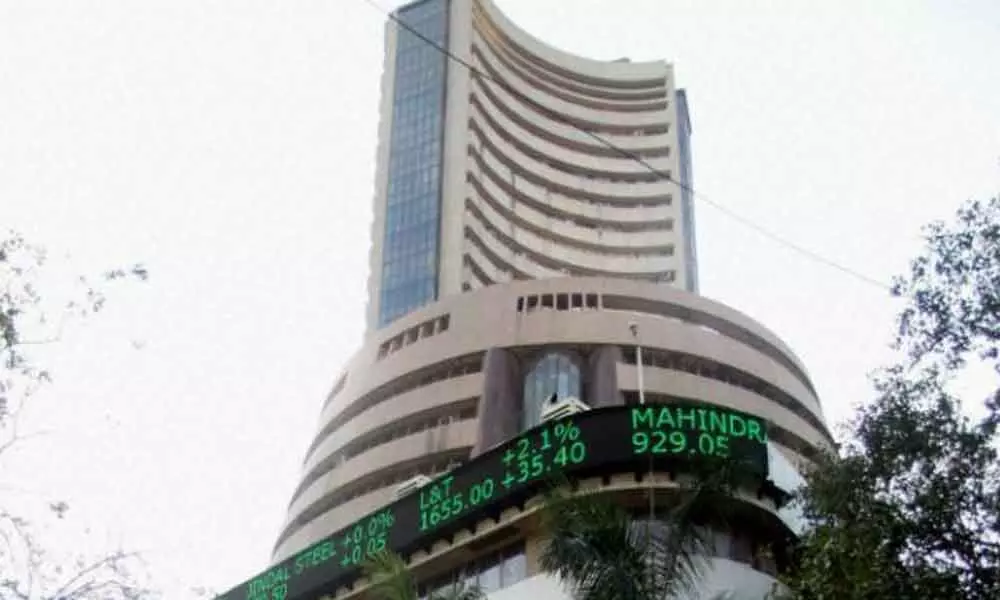Markets look to outcome of us fed meet

Markets look to outcome of us fed meet
Buoyed by the positive economic data, the announcement of a four-year moratorium on payment of adjusted gross revenues (AGR) for the telecom sector
Buoyed by the positive economic data, the announcement of a four-year moratorium on payment of adjusted gross revenues (AGR) for the telecom sector, a PLI scheme for the automotive sector and government guarantees for security receipts worth Rs30,600-crore to be issued by National Asset Reconstruction Company (NARCL), or the bad bank; markets touched new highs during the week ended September 17, 2021.
The BSE Sensex closed above 59,000-mark for the first time, rising 710.82 points or 1.22 percent to 59,015.89 points, and the NSE Nifty climbed 215.90 points, or 1.24 percent, to 17,585.15 points. Both the BSE Midcap and Smallcap indices also gained more than 1.3 percent each.
The Sensex so far gained 2.5 percent in September, increasing investors' wealth by nearly Rs9 lakh crore as BSE market capitalisation jumped to nearly Rs259 lakh crore from Rs 250 lakh crore. FIIs net bought Rs 6,476 crore worth of shares in the week ended September 17, taking the month's inflow to over Rs 7,200 crore.
Sebi has proposed the settlement period to be reduced to T+1, for the specified scrips which are opted for T+1 settlement by the exchanges and this shall happen by January 2022, which is still better for the stock market because this is beneficial for the seller as well as for the buyer.
Near term direction of the markets will be guided by US Fed meet, crude oil prices, movement of the dollar index and macro-economic factors. The US Federal Reserve's FOMC will meet on September 21-22 to take decisions on its monetary policy.
Automotive components manufacturer Sansera Engineering will make its debut on the bourses on September 24. The price band for the Paras Defence and Space has been fixed at Rs 165-175 per equity share.
Heard on the Street: Are You an Investor or a Gambler? The stock market knows. Small, inexperienced traders are piling into options, which can be a cheap way to hit the jackpot if you know what you're doing. If you don't, losses can accumulate quickly. You should learn whether you're an investor or a gambler before the market teaches you the difference. Stock gamblers are on the rise.
But, sooner or later, they will lose most—if not all—of their recent gains. Just look at options trading, which has been surging. Many traders use options as a cheap way to try hitting the jackpot: stock-market Sikkim Lottery. Small traders, big options individual traders have been loading up on speculative stock options in unprecedented numbers this year.
Cash market volumes have declined by eight per cent, while the turnover on the options segment surged 160 per cent from a daily turnover of Rs27 lakh crore in November2020 to Rs63 lakh crore in September 2021. Volumes in the cash market have declined consistently from Rs84,300 crore a day in May to Rs68,173 crore in August, down 19%.
Derived from the Latin optio, or choice, an option entitles but doesn't obligate you to buy or sell an underlying security at a fixed 'strike price' anytime until the option expires. A Call option can pay off if a stock rises; a Put, if it falls. Let's say you're optimistic about a stock and it rises above the strike price of your call before expiration.
You then can sell or exercise the option and earn a bigger profit with a smaller cash outlay than if you had bought the stock outright. On the other hand, if you expect a stock to fall, and it drops below the strike price before expiration, you can sell your put. You would make more money than if you had bet against the stock by selling it short.
During the early part of last week, for instance, highly volatile trading was seen on shares of Zee Entertainment where the returns were as high as 10,000 per cent on some of the OTM Calls. So why doesn't everybody trade options all the time? Because it's risky. And, although stock trades are literally free at most discount brokerages like Zerodha, you can't trade options—win or lose—without paying the premium.
Guess wrong a few times, and you'll be out thousands of rupees with nothing to show for it but a churning stomach. Because demand for options rises in sharply fluctuating markets, "premiums are higher than normal right now, so retail options buyers need sizable moves to make money. As jumpy as markets have been recently, they'd have to get even jumpier in a hurry to fulfill the dreams of many newbie traders.
Among the signs that someone is a trading addict: escalating trades to sustain excitement, borrowing money from friends or family to cover losses, lying about losses, and attempting and failing to quit. If this sounds like you, confess to your friends or family and get help before the market cures you the hard way: with massive losses that can wreck your life.
As experienced gamblers understand, it's vital to know what kind of game you're playing. Some forms of gambling—blackjack and poker are good examples—involve large amounts of skill alongside luck. Others, like the lottery or slot machines or roulette, depend almost entirely on luck. Trading options involves lots of skill if you know what you're doing—and nothing but luck if you don't.
F&O / SECTOR WATCH
Maximum Put Open Interest (OI) was seen at 17,000 followed by 17,600 and 17,500 strikes, while maximum Call OI was seen at 18,000 followed by 17,800 and 17,600 strikes. Call writing was seen at 17,800, 18,000 and 17,600 strikes, while Put writing was seen at 17,600, 17,700 and 17,400 strikes. India VIX moved up sharply from 13.94 to 15.23 on week-on-week basis, indicating volatile swings in the market ahead.
India VIX moved to its highest levels in more than three months and closed above 15 levels. The options data largely indicates that the Nifty may see a broader trading range of 17,300 to 18,000, while the immediate support and resistance for Nifty are now placed at 17,400 and 17,900 levels, respectively.
The Banking sector, which has underperformed till now, came into its own during the week. Govt guarantee, aggregating ₹30,600 crore, to the security receipts to be issued by NARCL puts a 18 per cent floor on recovery rate. The major benefit of NARCL would accrue through faster debt consolidation, potentially leading to quicker decision making and better recovery rates. Laggards in the sector like Kotak Bank have also started to participate.
PSU banks like SBI, Canara Bank, PNB and Union Bank can outperform from here on. PLI scheme for auto component companies is expected give fillip to the sector. Buy on decline Motherson Sumi. Ahead of Q2 earnings selective buying has been observed in IT counters. Stay invested for present. Developments in Zee Entertainment clearly show that a robust ecosystem is developing to keep promoter powers in check.
Watch out for similar developments in some more companies. Stock futures looking good are ITC, Indian Hotels, Kotak Bank, M&M Finance, SBI and Zee Entertainment. Stock futures looking weak are AU Bank, Glenmark, Bandhan Bank, Tata Steel and UPL.
(The author is a stock market expert. He is former vice chairman of AP Planning Board)
STOCK PICKS
Usha Martin Limited is engaged in the manufacturing of specialty steel and steel products. The company is one of the world's leading manufacturers of wire rope. The Wire and Wire Ropes segment includes steel wires, strands, wire ropes, cord, bright bar and related accessories, among others. The others segment includes jelly filled telecommunication cables, wire drawing and allied machinery, among others.
The wire rope manufacturing facilities located in Ranchi, Hoshiarpur, Dubai, Bangkok and UK produce one of the widest range of wire ropes in the world.
Global R&D center located in Italy, is actively engaged in designing of wire ropes and uses proprietary design software to develop products that are the best in class. Usha Martin also has a comprehensive R&D facility in their manufacturing unit at Ranchi in India. The company has an additional set-up for manufacturing conveyor cord and machineries at Ranchi. The group's cable business unit located at Silvassa in India, UM Cables Ltd manufacture high class Optical fibre cables, Copper cables, FRP rods, etc.
For specific products, Usha Martin has collaborations with globally reputed companies like Gustav Wolf of Germany, Joh Pengg of Austria and TESAC wire rope of Japan.
Why we are recommending?
1. Profit before tax margins has jumped from 3.5% to 11.5% on YoY basis. Profit after tax has jumped from Rs8.7 crores to Rs58.1 crores on YoY basis.
2. For full year the company is likely to report over Rs260 crores PAT compared to last year's Rs100 crore.
Buy between Rs69-71 for short term target of Rs85-90 (in 3 to 6 months) and medium term target of Rs130 (in 9 to 12 months). Risk /reward ratio is 1:7.















